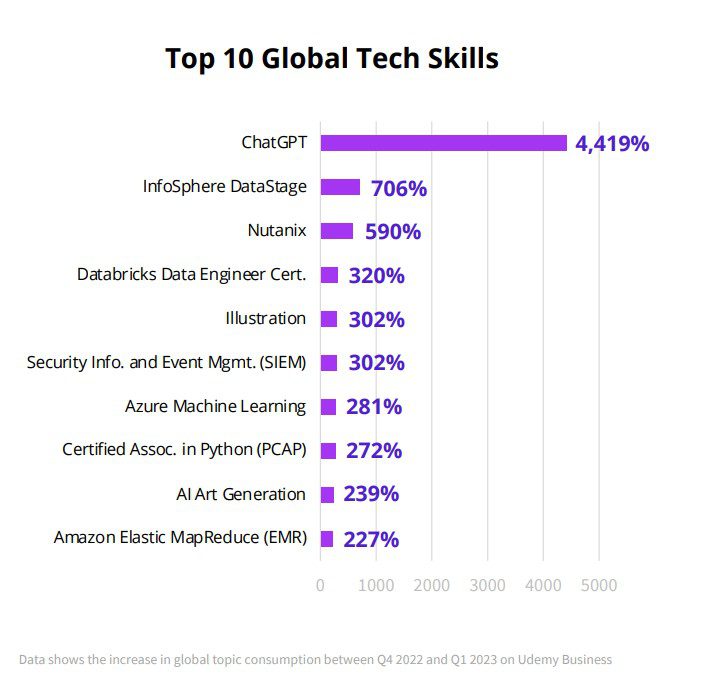ChatGPT is the most in-demand workplace skill
Here’s how to nurture that and drive efficiencies at work.
Why You Should Care
Generative AI is the term of the moment.
Employees want to use it more to drive productivity, according to Udemy's research.
Here's how to use technology to help drive efficiency at work.
Since November 2022, when OpenAI’s ChatGPT was released to the public, generative AI has been a huge topic of conversation.
Individuals across the world have been experimenting with generative AI platforms – and now research by Udemy has found that ChatGPT is the most in-demand workplace skill.
According to Udemy’s research of 14,000 business customers globally, the consumption (aka number of minutes spent on learning) of ChatGPT courses has increased 4,419% between the fourth quarter (Q4) 2022 and the first quarter (Q1) 2023.
US learners are particularly keen on ChatGPT – consumption has increased 5,226% among US learners since Q4.
In addition, 470 new courses on generative AI have been added to the platform globally – these have seen 42,000 new enrollments since the end of March 2023.
Productivity is key to why learners are so keen to upskill around ChatGPT. Udemy’s data show that employees are keen to use generative AI to improve their SEO keyword copywriting skills, for idea generation around visual presentations and for large-scale email creation.
Other AI and machine learning (ML) skills are also top of mind for learners globally.

Udemy’s Q1 2023 global workplace learning index.
Big tech embraces generative AI for work
Udemy’s senior director of engineering Jonathan Cremin tells UNLEASH: “I believe we are witnessing the beginning of the biggest disruption to society since the industrial revolution.
“ChatGPT’s rise surprised everyone in the AI business. It has quickly achieved results that, until extremely recently, even the most credentialed of academics believed were still decades away.”
The mass interest in ChatGPT may have taken many employers by surprise – but now is the time to really focus in on these skills, particularly given the productivity challenges workplaces are facing.
Cremin adds: “As AI begins to reshape the future, business leaders will need to both ensure they are seizing the opportunities it brings, while also ensuring they optimize their current business models and workflows.
“In the future, AI tools can help HR professionals analyze employee performance, predict attrition, and identify skill gaps for targeted training.”
While learning tech, like Udemy, is on hand to help with the upskilling side, other tech tools can help with optimizing workflows and actually introducing generative AI (and its efficiencies) into employer’s processes.
In addition to HR tech vendors like Beamery, Phenom and Eightfold embracing generative AI, big tech is also dialing up its focus on this new type of AI and its potential to drive workplace productivity.
Last week, Google, Microsoft and IBM all announced new generative AI tools aimed at the workplace. For instance, alongside the publication of its 2023 Work Trends Index, Microsoft expanded access to its new Microsoft 365 Copilot review tool.
This technology will leverage natural language to make Microsoft Teams meetings more efficient and creative, will coach individuals on how to write better emails and will help with idea generation in OneNote. Going back to the topic of learning, Microsoft 365 Copilot will also enable Viva users to personalize their learning journeys.
IBM’s Watson Orchestrate is a chatbot that also leans into skills and aims to remove boring, repetitive tasks from the workplace. While Google is teaming up with HR tech vendor UKG to implement large language models across the latter’s HCM technologies.
UKG’s chief product and technology officer Hugo Sarrazin noted: “We believe generative AI can be a tremendously powerful tool that changes how people go about analyzing information and insights at work.
“Our collaboration with Google Cloud will help employees and leaders make better decisions, have more productive conversations, and anticipate how today’s choices can impact tomorrow’s operations and workplace culture overall.”
Cremin concludes: “As the use of AI and natural language processing technologies becomes increasingly prevalent in various industries, early adopters of these technologies will have a significant advantage over their competitors.”
Employees and employers need to get on board, or risk getting left behind in the automated future of work.
If this article caught your interest, you can find more like it here. Enjoy!
Sign up to the UNLEASH Newsletter
Get the Editor’s picks of the week delivered straight to your inbox!

Chief Reporter
Allie is an award-winning business journalist and can be reached at alexandra@unleash.ai.
